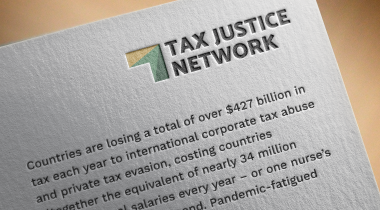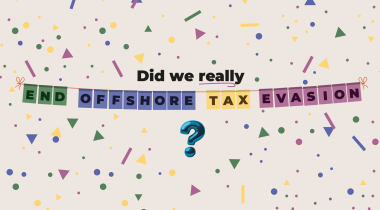
Bob Michel ■ EU ambition for DAC8 transparency on crypto is cut short by failure to think outside the OECD box

On 16 May 2023, the Council of the European Union reached agreement on the adoption of the latest proposal for amendment of the EU Directive on Administrative Cooperation (‘DAC’). The proposal for amendment – known as DAC8 – was launched by the EU Commission in December 2022 and serves the general purpose of ensuring that the EU’s automatic exchange of information regime stays in line with the evolving economy. More specifically, the DAC8 proposal intends to extend the regime to also include crypto assets and e-money. The amendment is being adopted under the ‘consultation procedure – general approach’ which means that a subsequent vote in the EU Parliament is necessary, but the outcome of the vote is not binding. The text of the DAC8 amendment agreed by the EU Council differs little from the original proposal by the EU Commission, and this despite the Commission receiving a plethora of feedback from the public during a public consultation round which ran from December 2022 to March 2023.
Automatic exchange of information↪NOTEAutomatic exchange of information is a data sharing practice that prevents corporations and individuals from abusing bank accounts they hold abroad to hide the true value of their wealth and pay less tax than they should at home. Learn more here. is one of the core policy measures advocated for by the Tax Justice Network since its inception in 2003. Together with beneficial ownership transparency and country by country reporting, the automatic exchange of information is a crucial part of what the Tax Justice Network calls the ‘ABC’s of tax transparency’, a set of crucial policy tools for the fight against tax abuse and illicit finance. Given that the DAC8 amendment aims to create a more comprehensive framework for automatic exchange of information that also includes information on crypto assets, the Tax Justice network welcomes the initiative.
However, the amendment does not fully seize the opportunity to improve the general efficiency of the EU’s automatic exchange of information regime. Furthermore, the new rules that will apply in relation to crypto asset transactions retain some of the current biases in the DAC, like the strict adherence to information sharing reciprocity in relation to third countries, and especially lower income countries. In addition, it is also far from certain whether the proposed rules catch all relevant crypto asset transactions.
To highlight and suggest solutions to these and other issues, we summarise some of the Tax Justice Network’s recommendations made to the EU Commission during the DAC8 public consultation round.
1. No country left behind.
As mentioned by the EU Commission in its proposal, the newly proposed rules on automatic exchange of crypto asset information have to be seen in the light of the parallel work of the OECD on its so-called Crypto-Asset Reporting Framework (CARF). The OECD first developed the CARF in March 2022, which was then approved by the G20 in November 2022. As of yet, the OECD has not delivered on developing the CARF implementation package. Such a package would consist of model legislation and a model multilateral competent authority agreement.
With its DAC8 amendment being all but final, the EU gives a clear signal that EU countries will no longer wait for the implementation of CARF. Information provided by foreign crypto asset service providers on resident taxpayer’s crypto asset ownership is a crucial tool to compel tax compliance by crypto asset owners. Such compliance is needed, both for the purpose of raising revenues and avoiding crypto assets putting pressure on countries’ tax gaps, as well as for taxpayer fairness. It simply cannot be that one type of asset is left to slip through the cracks of the tax reporting system.
The DAC8 amendment attempts to fill this crypto shaped crack. Under the new rules, EU Crypto Asset Service Providers (CASPs) – such as crypto exchanges, custodial wallet providers and brokers – will report information on the crypto assets held by taxpayers resident in EU countries. Providers that are not based in the EU will only obtain access to the EU market if they register in an EU country and comply with the reporting rules in this country. This extra-territorial scope of the directive squares the circle: no crypto-asset service provider will be able to offer crypto services to EU taxpayers without being subject to reporting obligations. The EU can afford this approach of leveraging market access to obtain tax information because the region is the world’s biggest crypto asset market. Foreign CASPs cannot afford to lose out on selling services to EU customers.
Obviously, EU countries are not the only ones in dire need of information on their residents’ crypto assets. Especially in lower income countries, where the grassroots adoption of crypto asset amongst the population is reported to be skyrocketing and crypto-induced tax gaps are widening, governments could do with the information on their resident taxpayers’ crypto assets. Many lower income countries cannot leverage market access to obtain tax information from foreign CASPs. The alternative solution of addressing crypto tax compliance issues by instating a ban on crypto assets has proven difficult to enforce. In Egypt, for instance, the government issued an absolute ban on crypto ownership and service provision as of 2019. In 2022, Egypt is reported to be the fastest growing crypto asset market in the Middle East/North Africa Region. Arguably, due to the local ban most locals rely on foreign crypto-service providers to own and transact crypto assets. Without international cooperation, this information is out of reach for the local tax authorities.
From this perspective, the forging ahead of the EU on this topic comes as a bittersweet development. Obviously, any effort to reinstate fairness of the tax system is to be welcomed. The EU should use its market leverage for ensuring global crypto transparency, eg by the speedy adoption of a single global standard, rather than push ahead for a regional standard with regional benefits only. Speeding up development of the CARF implementation package will not be aided by the fact that the biggest crypto market in the world now has its own plan to solve the issue, a plan that due to its extraterritorial reach does not require approval from any third country.
2. Beyond third-country reciprocity: the wider-wider approach in crypto asset reporting
The framework of international exchange of information in tax matters is built on the principle of reciprocity. Under the Common Reporting Standard (CRS), for example, countries exchange financial account information of non-resident taxpayers with only those countries that do the same in the inverse scenario. The idea of tit for tat has some merit in the case of similarly situated countries. But the world is a place of rampant cross-border inequality. Lower income countries simply do not have the administrative resources in place to meet the administrative standards to be eligible to send information, and thus they are not allowed to receive it, preventing them from finding out in which foreign countries local taxpayers have financial accounts. This lack of reciprocity affecting lower income countries makes little sense as well-off citizens of lower income countries tend to rely on financial institutions in high income countries to keep their wealth. The opposite is highly unlikely.
The Tax Justice Network has since long argued that the strict insistence on reciprocity in exchange of information works not only to the detriment of lower income countries but also risks being abused by the host countries of information holders to effectively prevent international administrative in tax matters from reaching its full potential. Allowing intermediaries to distinguish between ‘reportable clients’ (clients residing in participating jurisdictions) and ‘non-reportable clients’ (clients that need not to be vetted because they reside in a non-participating jurisdiction) opens the scope for all kinds of arbitrage and abuse.
For this reason, the Tax Justice Network’s Financial Secrecy Index assesses countries’ implementation of the so-called ‘wider-wider approach’. Under the OECD’s optional ‘wider-approach’, countries are encouraged to implement rules under the Common Reporting Standard which force intermediaries to employ the same ‘onboarding’ due diligence to all clients, both those residing in participating and non-participating countries. The ‘wider-wider approach’ goes one step further by forcing intermediaries to remit information on clients in non-participating countries to their local government. Although the country will not be able (or willing) to automatically exchange the information with the non-participating jurisdiction, it would at least be possible to draw up statistics on non-resident taxpayer activity and assets. The publishing of aggregated statistics on crypto asset information should not be controversial. It’s been shown in recent years that statistics on automatic exchange of information are a necessary tool to hold governments and intermediaries accountable and to reveal reporting irregularities, like penguins owning bank accounts.
The implementation of a wider-wider approach is especially relevant in the case of crypto assets. As noted by the EU Commission in its own DAC8 proposal, the characteristics of crypto assets make the traceability and detection of taxable events by tax administrations very difficult. If the EU wants to assume market leadership in the Web 3.0 era by providing EU CASPs with a solid regulatory framework, it cannot close its eyes to the fact that these EU CASPs might be instrumental to tax evasion in third countries, and especially, lower income countries. As such, it is highly regrettable that the EU has not seized the opportunity to implement the ‘wider-wider approach’ in DAC8 to oblige EU CASPs to provide information on the totals of crypto assets owned by residents in lower income countries. This information is key for those countries to assess the need for the development of solid domestic crypto tax rules and participation in the international exchange of a crypto asset information framework.
3. Call of duty to spontaneously exchange
The implementation of the ‘wider-wider approach’ might not make up for the fact that without legal ground in place (like the yet to be developed a CARF competent authority agreement), EU countries cannot automatically exchange crypto asset information with third countries.
The EU Commission should however have taken the opportunity in the preamble of DAC8 to remind EU Member States that besides the exchange of information rules in the DAC, all of the 27 EU Member States are also party to the Multilateral Convention on Mutual Administrative Assistance in Tax Matters. This convention is signed by over 120 countries, among which are a large number of lower income countries. Under Article 7 of the Convention, a country shall spontaneously exchange information that it has grounds for supposing may relate to a risk of tax loss in another country.
Spontaneous exchanges of information typically take place on a case-by-case basis, are not compulsory, and not comprehensive. As such, they cannot replace the automatic exchange of information. But even ad hoc exchanges of information gathered by European CASPs can help lower income countries to foster general tax compliance amongst crypto asset users, be it to serve as the basis of ‘nudge letters’ inviting taxpayers to correct their tax returns in view of newly received information, or as the start of full-blown tax investigation procedures of recalcitrant taxpayers.
Both the European Commission and the EU Member States should be reminded on this point that under article 208 of the Treaty on the Functioning of the European Union, the EU has accepted, as part of its development cooperation policy, to comply with the commitments approved in the context of the United Nations, like the UN’s Sustainable Development Goals. Arguably, the development of a crypto asset tax reporting system which serves the EU Member States own interests but that does not live up to its potential to contribute to domestic resource mobilisation in lower income countries, fails this obligation.
4. Silent elephants in the room: self-hosted wallets and decentralised exchanges
A final issue in the DAC8 amendment that deserves attention is the fact that the proposed reporting rules stay silent on the concept of self-hosted crypto wallets and decentralised crypto exchanges. Self-hosted crypto wallets allow individuals to set up accounts to own and transact crypto assets over the internet without the involvement of a CASP. Decentralised crypto exchanges are smart contracts embedded in the blockchain which provide for the ability to exchange crypto assets online and in a decentralised way, ie without the involvement of an intermediary. The DAC8 rules are however conceived on the mould of the DAC2/CRS rules and, as such, based on the assumption that crypto users rely on intermediaries to own and transact crypto assets. Just like in the case of the Common Reporting Standard, obliging these intermediaries to report on crypto users’ assets and income is presented as the silver bullet to tax compliance.
It is worth nothing that the crypto ecosystem is, however, fundamentally based on the premise of disintermediation. Unlike in traditional finance, intermediaries – the CASPs – are not indispensable for users to own crypto assets or undertake exchange transactions. Self-hosted wallet users can easily trade crypto assets by relying on peer-to-peer trades or by relying on fully decentralised applications. Given the lack of service provider involvement, this ‘dark side’ of the crypto ecosystem is fully out of the reach of tax authorities.
Under the new rules, CASPs should report transfers of crypto assets to or from self-hosted wallets, ie crypto wallets owned by users without involvement of a custodial entity. The EU commission admits this reporting is needed to help “track the wealth of a particular taxpayer”. The Tax Justice Network commends any measure that serves the purpose of registering wealth. It is highly doubtful however whether this measure alone – which echoes the extension of the ‘travel rule’ to crypto transactions under the EU Transfer of Funds Regulation as part of the 6th anti-money laundering package – is sufficient to deal with the phenomenon of self-hosted wallets. This doubt seems to be shared by the G7 Finance Ministers, who in their meeting communiqué of 13 May 2023 are calling for solutions to address the risks associated with peer-to-peer crypto-transactions beyond the implementation of the travel rule. As acknowledged by the European Commission itself, there is a clear need to track the wealth of crypto users, both for tax purposes and for anti-money laundering purposes. The global ownership of bitcoin, for example is both highly concentrated in the hands of a few owners who mostly rely on self-hosted wallets. Compulsory declaration of self-hosted wallet ownership by EU taxpayers and a European asset registry for crypto asset ownership above a certain monetary threshold are the only effective ways to track crypto wealth in the EU and to deal with the crypto ecosystem’s decentralisation and anonymisation in a technology neutral way.
The problem of self-hosted wallets is further exacerbated by the gain in popularity of decentralised exchange services. Decentralised exchange services are blockchain based applications that effectuate crypto asset trades between users entirely through automated algorithms and smart contracts. Like self-hosted wallets, fully decentralised exchanges allow exchanging crypto assets without involvement of a standard ‘centralised’ intermediary. Decentralised applications without identifiable persons with control or sufficient influence does not give rise to CASP status under the proposed DAC8 regime. As such, they allow crypto asset users (and especially those using self-hosted wallets) to exchange crypto assets without incurring any reporting of the transaction for tax information exchange purposes. Here too, the EU Commission is well-advised to devise rules on the registration or reporting of decentralised application use.
Without rules that fix the loopholes created by self-hosted wallets and decentralised applications, the DAC8 main purpose, which is to restore fairness in the tax system by ensuring tax compliance on crypto asset income just like any other income, will not be attainable.
5. Additional recommendations to maximise the DAC’s potential.
Finally, in the public consultation document, the Tax Justice Network makes a number of general recommendations to improve the DAC framework as a whole. These improvements are not included in the DAC8 amendment, but they should be if this latest amendment of the DAC is to live up to the DAC’s purpose as explained in one of DAC8’s recitals.
Recital 35a of DAC8 provides that:
“It is essential that the information communicated under Directive 2011/16/EU is used by the competent authority of each Member State which receives this information. Therefore, it is appropriate to require the competent authority of each Member State to put in place an effective mechanism to ensure the use of information acquired through the reporting or the exchange of information under Directive 2011/16/EU.’
Recital 35a was not included in the original proposal by the EU Commission. Its addition by the EU Council hopefully signals a willingness to make work of measures focusing of effective use of exchanged tax information, be it for compliance programmes, risk assessments or general audits.
The Tax Justice Network has since long advocated for measures that make the most of exchanged tax information, also for the purpose of wider policy development in the field of tax and anti-money laundering. As mentioned above, an important first step in this regard is the introduction of rules on the compulsory publication by EU Member States of aggregated statistics on information exchanged per-country on financial accounts and – in the near future – crypto assets. The EU should in this regard follow the example of countries like Argentina, Australia and Germany which recently have started publishing statistics on financial accounts held by non-residents. Additionally, the EU should adopt strategies for Member States to be able use the exchanged data in a pro-active way to map hidden offshore wealth planning.
The EU should also consider the introduction of measures that combine beneficial ownership transparency with exchanges of tax information, be it on request, spontaneous or automatic exchanges. Such measures are needed to tackle the loopholes in the exchange of information framework in the case of individuals holding bank accounts through foreign companies. This loophole was already pointed out by the Tax Justice Network at the time of inception of the Common Reporting Standard in 2014 but continues to persist until today.
A final recommendation concerns the specialty principle and the need to remove this principle from the DAC. Under the specialty principle, information exchanged under the DAC can only be used for tax assessment and tax fraud investigation purposes. However, the exchanged information is often instrumental for the investigation of closely related crimes, like corruption or money laundering. Just like many Latin American countries do under the Punta del Este Declaration, the European Union should also allow natural synergies to take place between administrative cooperation on tax matters and the fight against money laundering and corruption.
Conclusion
The EU is right to press ahead with addressing the secrecy and tax abuse risks posed by crypto assets. The OECD’s delay in putting out a timeline for the implementation of the CARF has meant the harms of crypto asset evasion continue to rack up. However, for third countries and especially lower-income countries, the adoption of DAC8 does not solve this problem.
DAC8 furthermore perpetuates some of the existing flaws in the DAC and in the OECD’s Common Reporting Standard, like the requirement of strict reciprocity for information exchange. Given the market leverage it wields in the crypto industry, the EU had a real opportunity to design a system that would secure transparency for all countries. DAC8 also perpetuates certain flaws present in the OECD’s CARF proposal, like the lack of a solution to deal with peer-to-peer crypto transactions.
Finally, the DAC8 amendment also squanders a good opportunity to revise the DAC regime as to the effective use of the exchanged tax information. Various measures can be taken and have been suggested, but besides recognising the problem in the preamble, DAC8 does not deliver.
Related articles

The Financial Secrecy Index, a cherished tool for policy research across the globe

Vulnerabilities to illicit financial flows: complementing national risk assessments

Do it like a tax haven: deny 24,000 children an education to send 2 to school

Tax Justice transformational moments of 2024

Did we really end offshore tax evasion?
How ‘greenlaundering’ conceals the full scale of fossil fuel financing
11 September 2024

10 Ans Après, Le Souhait Du Rapport Mbeki Pour Des Négociations Fiscales A L’ONU Est Exaucé !

Another EU court case is weaponising human rights against transparency and tax justice

The secrecy enablers strike back: weaponising privacy against transparency
Privacy-Washing & Beneficial Ownership Transparency
26 March 2024

